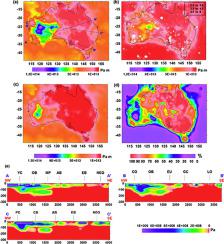当前位置:
X-MOL 学术
›
Glob. Planet. Change
›
论文详情
Our official English website, www.x-mol.net, welcomes your
feedback! (Note: you will need to create a separate account there.)
Strength variations of the Australian continent: Effects of temperature, strain rate, and rheological changes
Global and Planetary Change ( IF 4.0 ) Pub Date : 2020-12-01 , DOI: 10.1016/j.gloplacha.2020.103322 Magdala Tesauro , Mikhail K. Kaban , Alexey G. Petrunin , Alan R.A. Aitken
Global and Planetary Change ( IF 4.0 ) Pub Date : 2020-12-01 , DOI: 10.1016/j.gloplacha.2020.103322 Magdala Tesauro , Mikhail K. Kaban , Alexey G. Petrunin , Alan R.A. Aitken

|
Abstract The Australian continent is composed of several geologic provinces, showing a general age progression from Archean in the west to Phanerozoic in the east. The lithospheric heterogeneity and complex tectonic history of this region make it a key area for studying the thermal and rheological structure of the geological provinces and testing the influence of different conditions, such as temperature, rheology, and strain rate on the plate strength. In a previous study, temperature and compositional variations of the Australian upper mantle have been determined based on a joint interpretation of the seismic tomography and gravity data. In this study, we further implement a thermal model of the crust, based on available surface heat flow data from regional and global database. The crustal and upper mantle thermal models show different anomalies distribution, indicating a significant variation of the thermal conditions with depth. The new thermal models are used to estimate strength and effective elastic thickness (Te) distribution in the lithosphere. For this aim, we assigned the rheology of the crust based on the seismic velocities provided by the AuSREM model and used the strain rate values obtained from a global mantle flow model, constrained by seismic and gravity data. The maximal strength and Te are found in the West Australian Craton, on account of the low temperatures in the lithospheric mantle. We found that locations of the intraplate earthquakes attend to sharp changes in the lithospheric strength. Comparison of the results with those obtained for uniform rheology and strain rate, indicate that in the Officer basin the variations of the crustal rheology enhance the effect of temperature changes, while in the Yilgarn craton they reduce it. On the other hand, the lower values of the strain rate in the cratons than in the Phanerozoic regions influence the strength/Te in the opposite way with respect to temperatures.
中文翻译:

澳大利亚大陆的强度变化:温度、应变率和流变学变化的影响
摘要 澳大利亚大陆由多个地质省组成,呈现出从西部的太古代到东部的显生宙的总体时代进展。该地区岩石圈的非均质性和复杂的构造历史使其成为研究地质省区的热流变结构以及测试温度、流变、应变速率等不同条件对板块强度影响的重点领域。在之前的一项研究中,澳大利亚上地幔的温度和成分变化是根据地震层析成像和重力数据的联合解释确定的。在这项研究中,我们基于区域和全球数据库中可用的地表热流数据,进一步实施了地壳热模型。地壳和上地幔热模型显示出不同的异常分布,表明热条件随深度变化显着。新的热模型用于估计岩石圈中的强度和有效弹性厚度 (Te) 分布。为此,我们根据 AuSREM 模型提供的地震速度分配了地壳的流变性,并使用了从全球地幔流模型获得的应变率值,受地震和重力数据的约束。由于岩石圈地幔中的低温,在西澳大利亚克拉通中发现了最大的强度和 Te。我们发现板内地震的位置会引起岩石圈强度的急剧变化。将结果与均匀流变学和应变率的结果进行比较,表明在官员盆地,地壳流变学的变化增强了温度变化的影响,而在伊尔加恩克拉通,它们降低了温度变化的影响。另一方面,克拉通中的应变率值比显生宙低,对强度/Te 的影响与温度相反。
更新日期:2020-12-01
中文翻译:

澳大利亚大陆的强度变化:温度、应变率和流变学变化的影响
摘要 澳大利亚大陆由多个地质省组成,呈现出从西部的太古代到东部的显生宙的总体时代进展。该地区岩石圈的非均质性和复杂的构造历史使其成为研究地质省区的热流变结构以及测试温度、流变、应变速率等不同条件对板块强度影响的重点领域。在之前的一项研究中,澳大利亚上地幔的温度和成分变化是根据地震层析成像和重力数据的联合解释确定的。在这项研究中,我们基于区域和全球数据库中可用的地表热流数据,进一步实施了地壳热模型。地壳和上地幔热模型显示出不同的异常分布,表明热条件随深度变化显着。新的热模型用于估计岩石圈中的强度和有效弹性厚度 (Te) 分布。为此,我们根据 AuSREM 模型提供的地震速度分配了地壳的流变性,并使用了从全球地幔流模型获得的应变率值,受地震和重力数据的约束。由于岩石圈地幔中的低温,在西澳大利亚克拉通中发现了最大的强度和 Te。我们发现板内地震的位置会引起岩石圈强度的急剧变化。将结果与均匀流变学和应变率的结果进行比较,表明在官员盆地,地壳流变学的变化增强了温度变化的影响,而在伊尔加恩克拉通,它们降低了温度变化的影响。另一方面,克拉通中的应变率值比显生宙低,对强度/Te 的影响与温度相反。











































 京公网安备 11010802027423号
京公网安备 11010802027423号